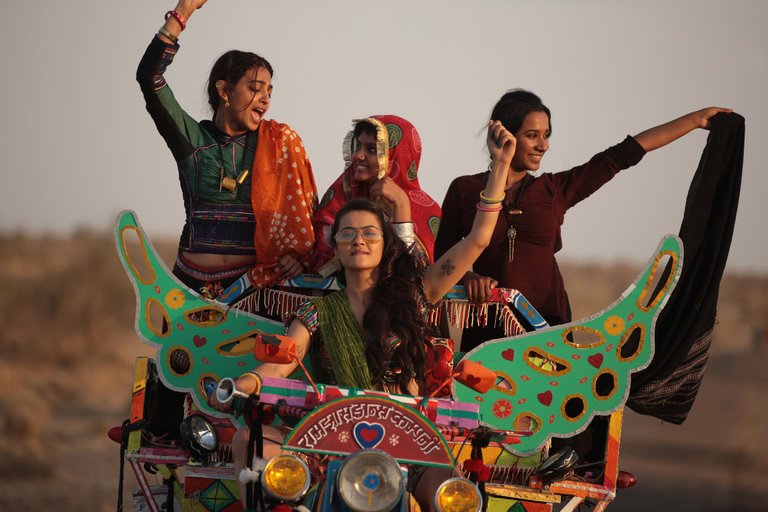Parched is a story of four ordinary women Rani, Lajjo, Bijli and Janaki set in a patriarchal village of Rajasthan, who unapologetically talk about love, men, sex and their lives.
Parched (2016)
Cast: Tannishtha Chatterjee, Radhika Apte, Surveen Chawla, Adil Hussain, Lehar Khan and Sayani Gupta
Director: Leena Yadav
In a lovely sequence in the film, Parched, two of its four main characters, comfort each other. Rani, played by Tannishtha Chatterjee (wow! what a powerhouse performance!) applies a soothing lotion to Lajjo’s (played by Radhika Apte) wounds. Lajjo has once again been beaten by her drunkard husband. A range of emotions flit across the women’s gently-lit faces as they explore each others’ injuries. In a sense, this scene is at the heart the movie: it’s a chronicle of women’s attempts to make sense of their scars, while exploring their sexualities, and trying to meet the world head on.
The two other protagonists are Bijli, played by Surveen Chawla and Lehar Khan who plays Janaki. While Rani, Lajjo and Bijli are friends, Janaki is Rani’s daughter-in-law, a child bride. In a heart wrenching scene, just after Janaki has been raped by her husband, Rani rebukes her for sleeping late, throwing the usual taunts of “Didn’t your mother teach you anything?” As the child limps towards the bath area my heart all but leapt out of my chest. Rani is as much a product of the society she lives in and mistreats her daughter-in-law the same way she was treated when she herself had been a child bride.
Later, in a poignant monologue to her mother-in-law Rani narrates her life events, most of it a tragic unfolding of events beyond her control. She states quite matter of factly, that despite assurances of an improvement in their situation, nothing does.
Bijli, the hard-as-nails sex worker, is saved from looking stereotyped only by Surveen’s impressive performance. Though she may appear bindaas and carefree, she longs for a “regular” life. Despite the fact that she sets the terms of sale of her body, she is unable to stop violence and abuse. I’m yet to see on the Indian screen a sex worker with true agency. The portrayal seemed problematic to me for a movie so progressive at heart.
In one of the heart-gooey-making sub plots the women of the village band together to successfully get a satellite TV dish installed, despite opposition from the men. The other interesting sub plot is the love story of Kushan and Naobi, a Manipuri woman. Their marriage causes much consternation among the menfolk of the village. With every blow to the patriarchal order, I sent up a cheer. Dear director Leena Yadav, hope you have many more to come!
While the older men disapprove of Kishan’s marriage, the younger boys sexually harass Naobi. One of these harassers is Gulab, Rani’s son. He has scant respect for his mother while stealing money she is saving up to repay loans she took for his wedding. Rani finally finds it in her to stand up to him and steps in to stop his abuse of his wife.
Adil Hussain plays a nameless dream lover who helps women discover their bodies while giving them huge orgasms, it seems. Slight eye roll happened there. Lets face it ladies, does such a man really exist? Here’s an apparently homeless man with nothing to recommend him save his great sexual prowess. The sequence of love making, however, is very beautifully shot.
Another gorgeous sequence is the women frolicking in the water in the dark, sharing laughter and camaraderie, something not seen in Bollywood or Hindi language cinema-at least that which I’m familiar with.
Here is a movie which lets women speak in their own voices. We watch them negotiate their lives, struggle with the realities of gender and discover the pleasures of their sexualities as they traverse the course of the movie. These women may not always be triumphant but they try; they are active agents in their own lives. In the end, they all don’t come out flawless, but each woman grows with the arc of the narrative. This is what a feminist film looks like!
To end, here is an apt cartoon by Karnika Kahen, feminist and popular cartoonist Kanika Mishra.

Kanika says, “Parched makes a strong statement about freedom from the patriarchal attitude of the Indian society.”
Featured Image Credit: NYTimes.com
About the author(s)
A teacher by profession, a student of women's and gender studies, a life long learner and passionate feminist. Come, let me tell you why we should all be feminists!




